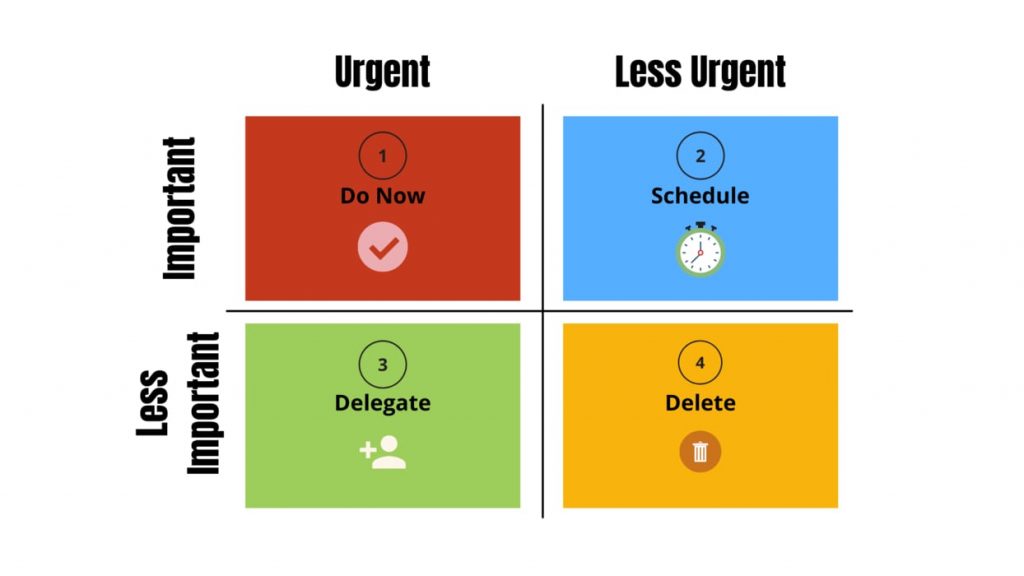They say that whoever manages to master time will become all-powerful.
When you come to think of it, there is some truth in this because human beings are capable of great things as long as they have the time to achieve them.
Whether you’re a student, a professional, an entrepreneur, or simply looking to make the most of your day, effective time management is essential.
If you strive for greatness and you want to boost your productivity, we’ve prepared for you 15 time management allocation techniques:
- The Pomodoro Technique
- Task Batching
- Eating the Frog
- Golden Hours
- Eisenhower Matrix
- 80/20 rule
- Automate your tasks
- Plan your day
- Make to-do lists
- Prioritize tasks
- Eliminate distractions
- Elon Musk’s “time blocking” method
- Track your time (use time tracking apps)
- Define MITs (most important tasks)
- Do not multitask (loss of productivity)
These tips might not teach you how to master time but they might bring you closer to the goal.
How to manage time?
There are many different time management strategies that you can easily apply to your day-to-day activities to reduce your stress levels.
It all depends on your goals and self-discipline because you might plan well but you also have to stick to the schedule you created to be productive.
Thus, you should be realistic and create doable schedules.
I understand that you are eager to tackle everything in one day but even machines need some rest otherwise they overheat.
You will have to experiment with a lot of different methods, techniques, and systems until you find out which one works the best for you.
1. The Pomodoro Technique
Toggl says that this technique can be a solution to your worries if you have noticed that your co-workers or employees get easily distracted.
All you have to do is to persuade them to set the timer.
The technique distributes your workload more evenly throughout the day and helps you keep your focus on the task.
- Take your to-do list
- Choose the task you want to complete
- Set your timer for a 25-minute block (aka one Pomodoro).
- Don’t multitask, and don’t interrupt your working process with small distractions. Work solely on the task of your choice.
- When the time is up, you have earned yourself a 5-minute break.
- After 4 cycles of Pomodoros, take a longer break – 20-ish minutes.
2. Task Batching
If you are constantly multitasking but realize that at the end of the day, you haven’t fully completed not even one of your to-dos, the task batching technique can be the right one for you.
Grab your to-do list and a bunch of highlighters and get to work.

The goal is to find a few tasks in your list that are similar and could be done at once.
With the help of different highlighters, you will be able to group activities into categories based on their similarities.
You might be used to tackling urgent matters first and this could change the order a bit, but it will actually make you more productive than before if you tend to get off track easily.
💡 Pro tip
Organizing meetings often takes time and resources. Luckily, there is a tool that can help you manage your time more effectively.

3. Eating the Frog
Are you struggling to complete the more challenging and unpleasant tasks? Are you a fan of procrastinating?
Again, grab your good old friend – the to-do list, and a sip of courage, and do the worst task you see on the list.
This technique is inspired by Mark Twain who once said that if a man’s job consists of eating a frog, then the first thing he should do in the morning is to eat that frog. Maybe he could have used a more pleasant example to illustrate his message.
Anyway, the idea is that a person should be dealing first with the most unpleasant tasks of the day. Then it only gets better.
4. Golden hours
It is impossible to stay motivated at all times. A person is constantly influenced by other circumstances, moods, feelings, and thoughts.
Therefore, you shouldn’t judge yourself harshly if you are lacking focus or motivation.
This time management activity is quite similar to the Circadian Rhythm with the sole difference that you can do it for personal purposes, instead of for trying to build the perfect team.
Start a journal where you document your workdays. Try to keep it for a week or so.
Describe how your day is going and when you are feeling the most productive in order to find the pattern. This will help you determine your golden hours.
From now on, you’ll know when to take on the more energy-demanding stuff.
5. The Eisenhower Matrix
This time allocation strategy is related to the feeling of disorientation when you have tons of work and no idea where to start.

- Grab a blank sheet of paper and divide it into four equal quadrants.
- At the top, label the two columns “Urgent” and “Not Urgent”.
- Name the rows “Important” and “Not Important”.
- Drop your tasks into their designated categories.
- When you have them all ordered, follow this system:
- Urgent and Important: First to be done.
- Urgent and Not Important: Next in line.
- Not Urgent and Important: Create a plan for action.
- Not Urgent and Not Important: Why bother at all? Scratch them off.
This is great on its own but could also be a complement to any other prioritization technique.
6. 80/20 rule
The 80/20 rule, also known as the Pareto Principle, is a time allocation technique that suggests that our daily tasks are divided into 2 sections – vital and trivial.
The vital tasks take up 20% of our to-do list, while the trivial, more simple, tasks are 80%.
It is important to understand this rule since it can be applied to everything in our life. Including handling our businesses.
💡Pro tip
Determine what are the most important tasks for the day and focus your time on them. This will help you be more productive and efficient. The 80/20 rule can be applied to everything in your life but it’s especially helpful if you run a business.
Before you begin work, always ask yourself, “Is this task in the top 20 percent of my activities or the bottom 80 percent?”
The rule for this is: resist the temptation to clear up small things first.
7. Automate your tasks
I bet you’re fed up with dealing with repetitive manual tasks that a machine could easily do for you. All you need is the right software or a set of tools.
The process of automation could reduce operational costs, increase reliability, and give you more time which you can spend on something of greater importance.
Different platforms could offer you the best automating tools.
You might be asking what could be automated?
- Marketing, more specifically – social media posts.
- Administrative tasks such as scheduling appointments and sorting emails.
- Finance and accounting – managing invoices and calculating sales tax.
8. Plan your day
If you plan your day in advance, you’ll be way more organized. That’s facts.
You might think that you’ll systemize what you are doing throughout the day or as soon as you wake up, however more often than not that’s not the case.
You might wake up and not feel in the mood for doing anything in particular, that’s why you should have a clear idea from the day before.
Self-discipline also plays a huge role, because if you are running your own business, then you don’t have a boss to tell you what you MUST do.
You’ll have to motivate yourself and never listen to that inner voice that tries to persuade you that procrastination is a nice option.
9. Make to-do lists
To-do lists are the ultimate time allocation tools because they give you a clear idea of what is left for you to complete.

If you don’t write all the tasks down or you forget to update your already existing list, you might forget something.
An entrepreneur’s day is a hectic one, don’t rely on your good memory.
When you put everything on paper, you are also able to reflect on your tasks and batch together some of them.
Let’s not forget about the feeling of self-satisfaction when you cross something off the list, which can motivate and inspire you to do one more.
10. Prioritize tasks
I already mentioned the 80/20 rule. It is an illustration of the ratio of unimportant to important activities.
In order to be efficient, you should prioritize and complete important tasks first.
They might take more time; they might be more difficult to tackle. However, at the end of the day, they will be way more beneficial in comparison to the rest.
If you get used to dealing with trivial to-dos, you will always leave the most pressing matters for later which is an absolute no-no in the professional world.
Also, completing the more insignificant tasks might leave you with a deceitful feeling that you’re day has been fruitful, which is not the case.
11. Eliminate distractions
There is this saying that we make plans so that life (or destiny) could cancel them. Consider distractions as life’s little attempts to throw you off the road.
Of course, if it is something really important, then you should deal with it ASAP.
But don’t waste too much time paying attention to what’s not going to damage you a great deal or help you a great deal.
Time allocation is not an exact science and you should always keep in mind that unexpected things happen and they might delay you.
Try to be prepared and whatever happens, don’t lose focus on your goals.
12. Elon Musk’s “time blocking” method
What time allocation technique does Elon Musk use? It’s so simple and yet so efficient.
- Divide your whole day into 5 minutes slots.
- Order the tasks for the day and think about how much time each one will take.
- Assign tasks to specific time slots in your calendar.
- Execute those tasks exactly as it is given in your calendar. Don’t prolong, and don’t multitask.
- One time slot = one activity.
This method will merge your to-do list with your calendar and will help you avoid procrastination.
13. Track your time
When you track your time you are aware of how much time a specific task takes you. This could help you immensely when you plan your next day.

You’ll have a clear idea of whether a task is time-consuming or not and you’ll be able to structure better schedules and meet deadlines.
You’ll also be conscious of the amount of time spent on unimportant activities and you’ll either reduce it or move on to the next thing.
It’ll be easier for you to notice that you’re getting stuck.
14. Define MITs
As I have repeated a few times in this article, any entrepreneur must be able to distinguish between the Most Important Tasks and the ones that could wait a bit.
But how do you do that?
What is the most important among them all?
Anything that could affect your income should be considered critical and should be dealt with ASAP.
It doesn’t matter whether it has a negative or a positive effect, do that first!
Usually, you should have one or two pressing matters of this kind per day. They tend to be more complicated and time-consuming, therefore you should never let them pile up!
15. Do not multitask
Multitasking is the number one enemy of time allocation techniques for various reasons.
- You get easily distracted.
- You start doing different things at the same time and they end up uncompleted.
- You don’t follow a clear plan and you might get confused.
- Being overwhelmed by the workload is also a key downside.
- Even if you manage to complete everything, the quality of execution won’t be as good as it would be if you had focused on one thing at a time.
Overall, I highly advise you against taking up this activity no matter how little time you are left with.
It’s better to apologize, explain and do it properly with a delay, instead of making a botch out of the task.
Combine various time allocation techniques to get the best of your day
I hope that we’ve managed to provide you with the best manual for time management activities and that you’ll be able to go into the day more confidently than ever.
Don’t forget that you can use different time allocation strategies for different situations and you can also combine a few of them to be as efficient as possible.
Experiment, try out different things, and see what works like a charm for you.
After all, a true time master has many tricks up their sleeve.
PS. Don’t forget the good old time management worksheet. An hour of planning saves you hours of doing.



